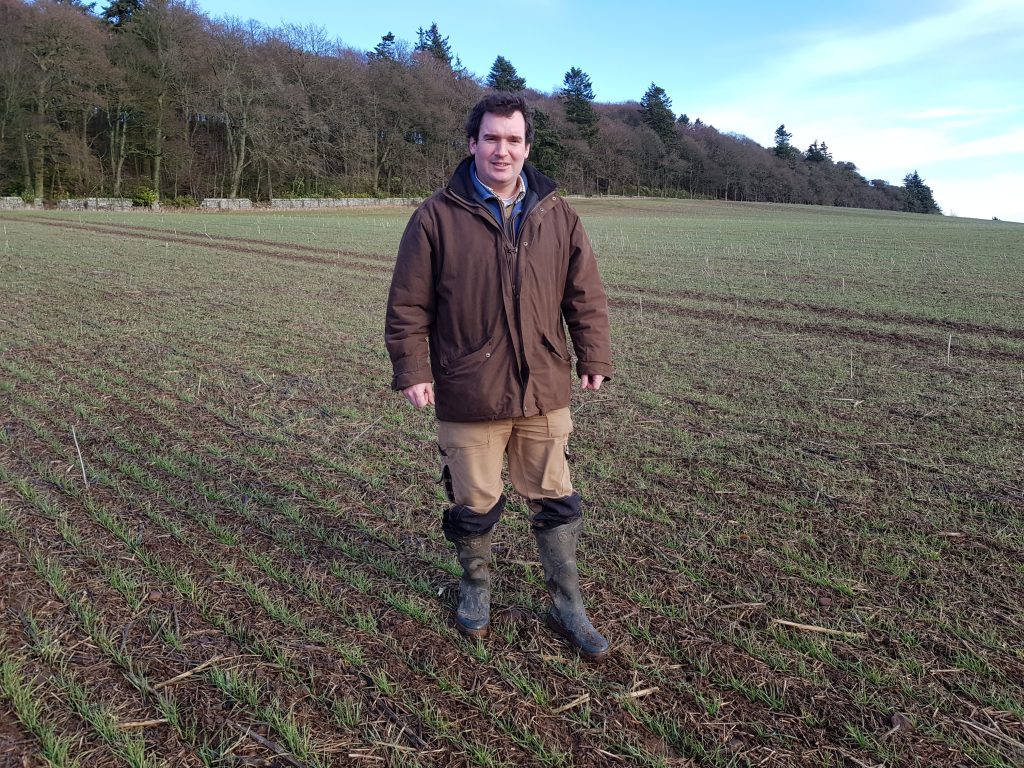Strong early vigour sees Limagrain conventional OSR variety find favour in Angus
6th July 2018
There has been a long running debate on the merits of hybrid versus conventional oilseed rape varieties, particularly in the harsher conditions of northern England and Scotland. For one Central
There has been a long running debate on the merits of hybrid versus conventional oilseed rape varieties, particularly in the harsher conditions of northern England and Scotland.
For one Central Angus grower, however, that debate has now been put to bed and he is now growing all conventional after one open-pollinated variety showed its mettle in a tough Autumn.
James Hopkinson manages about 1,000ha of cropping under the umbrella of Arable Ventures, a Joint venture (JV) set up in 2014 between two family farming businesses.
Based around Kirriemuir & Forfar, the business produces combinable crops, and lets out land for vining peas and potatoes, with about 175ha of oilseed rape in the rotation, depending on the season.

James Hopkinson.
Mr Hopkinson says he has experimented with hybrids, alongside conventional open pollinated types such as Anastasia and Nikita on the recommendation of Nick Wallace of NIckerson.
During autumn 2016, his strategy was to favour a hybrid variety for the later drilling slot up to mid-September, but after running out of seed had to use some Anastasia seed finish off some end rigs.
Growing the two side by side, there was little difference between the two varieties, even in such a late window, and going into the winter conventional Anastasia looked much better than its hybrid counterpart.
“It proved to me that hybrids in that situation aren’t necessarily all they are cracked up to be, with Anastasia having enough vigour, even when sown so late,” explains Mr Hopkinson.
Northern performer
The variety’s early vigour is one of the key reasons for the variety’s consistently high performance in the North, yielding 106% of controls and up with the latest recommended varieties some five years after its first listing.
It also has a resistance score of 7 for light leaf spot, a disease that can play havoc with northern growers in a high-pressure year and is short and stiff, so stands well in adverse conditions.
Taking an integrated approach to his crop management, the light leaf spot score of Anastasia is something that appeals to Mr Hopkinson to aid the judicious use fungicide inputs.
Disease risk was relatively low during 2016-17 and farm manager applied no fungicide to its two oilseed rape varieties – Anastasia and fellow conventional Nikita – and average yields still came in at a bumper 4.6 t/ha.
“Unless light leaf spot pressure is high, we won’t treat for it – you can’t blanket spray and should assess things on a field-by-field basis.
“I did find significant levels of sclerotinia sclerotia in the stubbles after the combine last year though, so we will have to use a flowering spray as a matter of coarse, particularly as we have [sclerotinia hosts] vining peas, potatoes and carrots in the rotation too.”
As Arable Ventures approaches its fourth harvest, Mr Hopkinson will again be cutting Anastasia and Nikita, alongside a small area of Campus. One field of Anastasia has also been entered in to ADAS’s Yield Enhancement Network (YEN) competition.
Both Anastasia and Nikita will be in drilling plans for autumn 2018 and Mr Hopkinson notes Anastasia is the only variety that has featured in every season since the business started back in 2013.
“I’ve tried others, but it has been so consistent and is now well-proven [on our farm]. It establishes well, has a good light leaf spot score, stands and yields, so you can’t ask for more,” he adds.
Canopy management
Limagrain’s oilseed rape breeder Vasilis Gegas says no obvious weaknesses stand out in Anastasia’s Recommended List statistics and is the driver behind its continued growth in market share.
However, he says one thing growers must be wary of is drill date, with its powerful early vigour potentially leading to an over-thick canopy in good conditions.
“Anastasia gives you a good early plant population and grows away well in a range of environments, but if you drill too early, you will have to manipulate the canopy with PGRs [plant growth regulators] and nitrogen.
“Use green area index measurements to adjust rates and don’t go crazy with seed rates – aim for a target plant population of 25-35 plants/m sq,” explains Dr Gegas.
Key variety features – Anastasia
| Type | Conventional open-pollinated |
| Recommendation | North |
| Gross Output | 105% (UK 101%) |
| Resistance to lodging | 8 |
| Stem stiffness | 8 |
| Light leaf spot | 7 |

